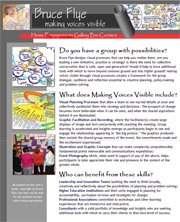As ICA presents it, it's a sequential process, and that bothered me initially. Although they point out the importance of acting on our values, it seemed that those two pieces needed a stronger connection. There was also a need for "reality" to get in there somewhere. It eventually occurred to me to think of this process as two loops that connected through Reality, and I drew it for myself as shown here.
This process is taught for use in a facilitated engagement. To ICA and others who have presented similar sequences I have always inquired: "I work in
 a university, and we claim to require data. Where does the data come in here?" There's never been a satisfying answer. Recently I was asked to help a campus group talk through the start of a planning process, and their first and highest concern was how to tackle what appeared to be a an enormously complex situation analysis. In the scripted process they were using, this piece of work was near the middle of the sequence. I scribbled out the ToP methodology for them and asked "What if we looked at our situation first, instead of later?" What emerged in the conversation was a third loop that may well answer my questions about data and other tools for getting at reality.
a university, and we claim to require data. Where does the data come in here?" There's never been a satisfying answer. Recently I was asked to help a campus group talk through the start of a planning process, and their first and highest concern was how to tackle what appeared to be a an enormously complex situation analysis. In the scripted process they were using, this piece of work was near the middle of the sequence. I scribbled out the ToP methodology for them and asked "What if we looked at our situation first, instead of later?" What emerged in the conversation was a third loop that may well answer my questions about data and other tools for getting at reality.It seemed to me that we might best start by looking at the situation very broadly, and then "noticing what we notice." By taking stock of emergent issues we spend our time on things that are more likely to be important. In this instance, I recommended a World Cafe that might be quite large to assure that we had the entire system in the room. Knowing that a carefully crafted question would yield a cogent collection of topics, we could drill down as needed. Data-gathering and validation methods could be chosen to suit the issue: focus groups, surveys, Walkabouts just to name a few. The findings could then be synthesized and converged into "the story," an elegant narrative easily told by anyone that accurately describes the situation we're about to work with. Once we can do that, we should have a solid and shared context within which to ascertain our organizational identity.
 Such a whole system/divergent/convergent process has features worth paying attention to. First of all, it doesn't really care about top-down thinking, and instead allows important issues to emerge on their own. It doesn't respect silos either, and there is little that will be off-limits. It can be a hugely creative experience with persistent dialogue among those doing the data-gathering. Although the book Good to Great is sometimes accused of having done harm because it gets used as a cookbook, the really fascinating story in it is about how they discussed and probed their findings in dialogue with each other in order to develop their conclusions.
Such a whole system/divergent/convergent process has features worth paying attention to. First of all, it doesn't really care about top-down thinking, and instead allows important issues to emerge on their own. It doesn't respect silos either, and there is little that will be off-limits. It can be a hugely creative experience with persistent dialogue among those doing the data-gathering. Although the book Good to Great is sometimes accused of having done harm because it gets used as a cookbook, the really fascinating story in it is about how they discussed and probed their findings in dialogue with each other in order to develop their conclusions.A few days after this discussion, I began getting ready for a teleconference about a workshop I'll present in June. For this particular association, we use Russell Ackoff's Idealized Design as a framework for surfacing the many issues that arise in university planning. This third loop that has emerged offers some similarities to "designing the mess" as described by Dr. Ackoff. If we were to find a place to insert a bit of systems thinking into this emergent approach to a situation analysis it just might really become something!



No comments:
Post a Comment